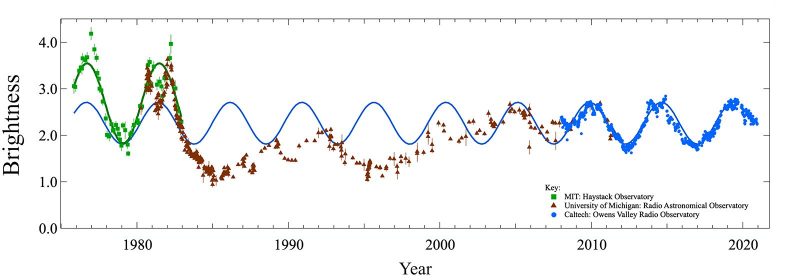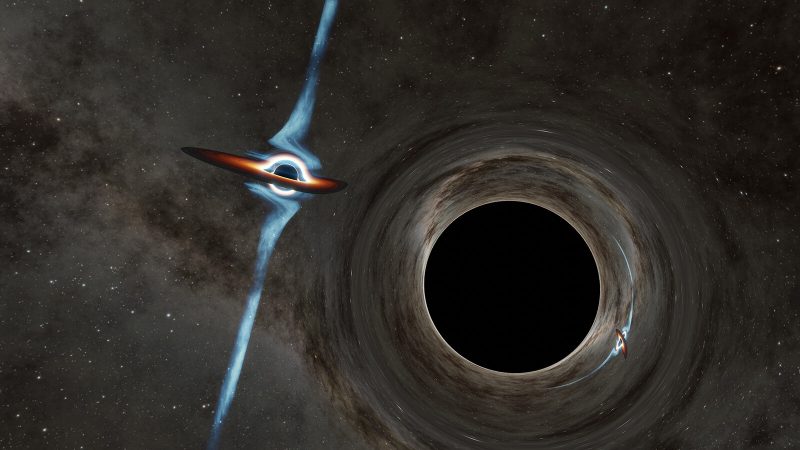Astronomers said in late February 2022 that they believe they’ve found the closest pair of supermassive black holes yet. The holes are about 2,000 astronomical units (AU) apart, or 2,000 times the Earth-sun distance. These two black holes are locked in a death spiral, drawing ever nearer toward a cataclysmic explosion. In 10,000 years, these astronomers said – a blink of cosmic time – these two black holes will collide. Their fantastic merger will rock the fabric of space and time, sending gravitational waves across the universe, as predicted over 100 years ago by Albert Einstein.
The astronomers published their study on February 23, 2022, in the peer-reviewed publication The Astrophysical Journal Letters.

Black holes, quasars, blazars
This pair of black holes lie in a galaxy 9 billion light-years distant. They orbit a common center, completing one lap in a time approximately equal to two Earth-years. Each supermassive black hole contains hundreds of millions of solar masses.
The astronomers made the discovery by observing a quasar named PKS 2131-021. A quasar is an active core of a galaxy that’s bright in radio waves. It’s bright because the supermassive black hole at the center of the galaxy is siphoning material and producing a jet gushing at near light-speed that we can see in radio waves. The quasar PKS 2131-021 is also part of a subcategory of quasar known as a blazar. A blazar is a quasar whose jet points toward Earth.
Why are there so many different names for the activity of supermassive black holes in galaxies? Because when scientists first discovered them, they categorized them by how they appeared from Earth. Only later did they realize that they were all different views of a black hole at the center of a galaxy.
A light curve revealed the duo
The astronomers made their discovery using 45 years of data collected on quasar PKS 2131-021. Five different observatories recorded observations of periodic shifts in radio brightness from the quasar. The radio data from these telescopes create a plot of a nearly perfect sinusoidal light curve. The smooth, continuous wave pattern is a product of the black hole pair’s orbital motion shifting back and forth. This light curve is unlike anything scientists had seen from a quasar before.

How they discovered it
Tony Readhead of Caltech, an author of the paper, had been studying blazars since 2008. He and his colleagues were trying to learn how black holes turn the disk of material they consume into the jets that we see. They had analyzed some 1,000 blazars when, in 2020, they found an unusual case: PKS 2131-021. Readhead said:
PKS 2131 was varying not just periodically, but sinusoidally. That means that there is a pattern we can trace continuously over time.
Which raised the question, how far back in time could they trace this light curve?

His team searched archival radio data and found peaks from 2005 and 1981. Readhead said:
The story would have stopped there, as we didn’t realize there were data on this object before 1980. But then Sandra picked up this project in June of 2021. If it weren’t for her, this beautiful finding would be sitting on the shelf.
Lead author Sandra O’Neill of Caltech may not be the hero you expected. She was an undergraduate majoring in chemistry who decided to take a summer program in astronomy to stay busy during the pandemic. O’Neill said:
I came to realize I was much more excited about this than anything else I had worked on.

O’Neill found PKS 2131-021 data from 1976 that fit their curve. She said:
When we realized that the peaks and troughs of the light curve detected from recent times matched the peaks and troughs observed between 1975 and 1983, we knew something very special was going on.
Ticking like a clock
The scientists describe the jet moving back and forth to the ticking of a clock. Each cycle of the sine wave corresponds to a circuit in the black holes’ two-year orbit. (Fun side note: The observed cycle is actually five years due to light being stretched by the expansion of the universe.) The team saw the ticking of the black holes starting in 1976 and for the following eight years. Then the clock temporarily switched off. The scientists guess it was due to a change in the fueling of the black hole. Then, 17 years ago, the ticking began again, and it’s continued ever since. As Readhead said:
The clock kept ticking. The stability of the period over this 20-year gap strongly suggests that this blazar harbors not one supermassive black hole, but two supermassive black holes orbiting each other.
Team member Roger Blandford from Stanford helped solve the mystery of why the blazar produced the sine wave. Readhead explained:
We knew this beautiful sine wave had to be telling us something important about the system. Roger’s model shows us that it is simply the orbital motion that does this. Before Roger worked it out, nobody had figured out that a binary with a relativistic jet would have a light curve that looked like this.
Dual black holes
Scientists assume most large galaxies have a supermassive black hole at their centers. The galaxy the team studied probably gained a second supermassive black hole through a galaxy merger.
The pair of orbiting black holes are already sending out ripples across spacetime in the form of gravitational waves. Gravitational-wave observatories such as Laser Interferometer Gravitational-Wave Observatory (LIGO) aren’t able to detect those waves, however, because of their low frequency. While future observatories, such as Laser Interferometer Space Antenna (LISA), may be able to detect black holes such as these, scientists’ current best resource is analyzing their light curves.
Astronomers had already detected one previous pair of orbiting supermassive black holes, OJ 287. The irregular pattern from these black holes suggests they orbit each other once every nine Earth years. They are probably 10 to 100 times farther apart than PKS 2131-02.

Bottom line: Astronomers recently spotted the tightest-knit pair of supermassive black holes ever seen. They will collide in 10,000 years, shaking the fabric of spacetime.











